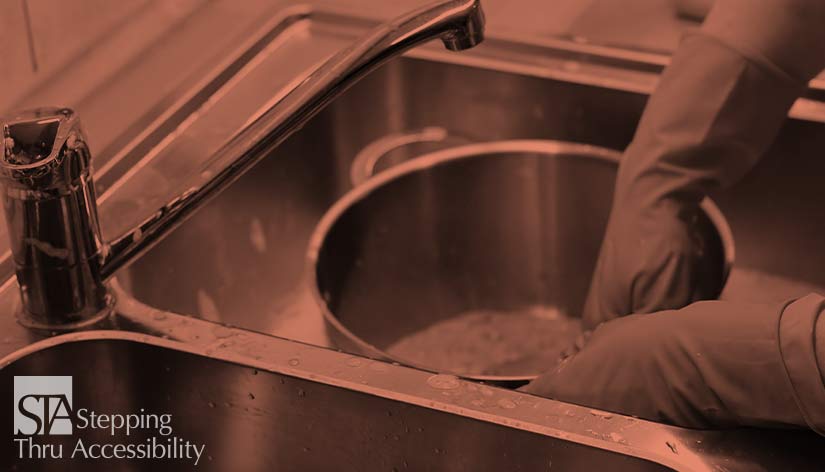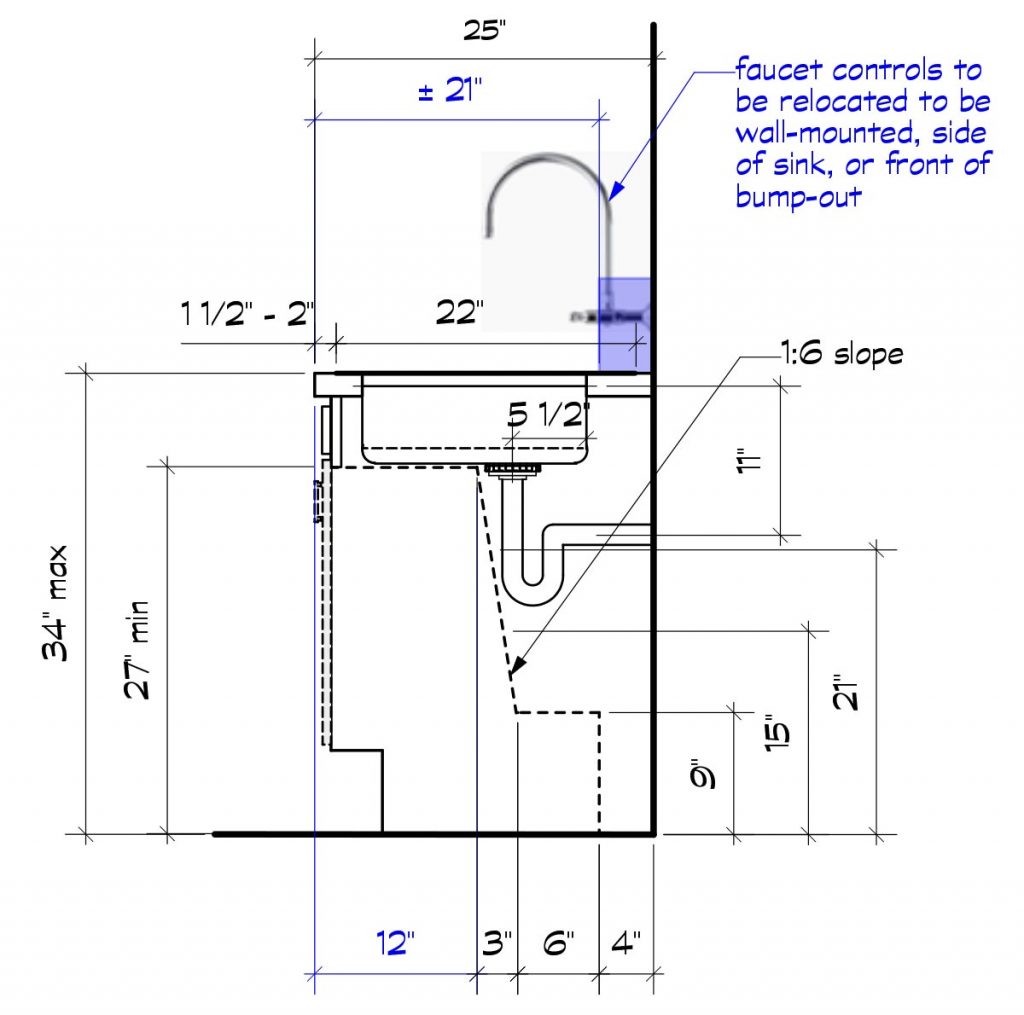Blog
Return to Blog »
Janis Kent, Architect, CASp © June, 2020 One of the more difficult issues about making a kitchen sink accessible is reaching the faucet controls. The majority of people start from the front of the counter and look at the knee/toe clearance beneath. If they provide the 17″ minimum for ADA or 19″ minimum for California Building Code (CBC), the calculations seems to stop at that point. But this will not necessarily provide a front approach for access to the faucet, for both the spout and its controls. Do note that the following is not applicable to a bar sink or a service sink since a parallel approach only is required. I have found that it is easier to start from the back wall. Looking at a typical top- or under-mount sink, the depth tends to be 22″ if the holes are provided. The manufacturer suggests the front of the sink be placed 1½” from the front edge of the counter or even 2″. This leaves ½” to 1½” from the back of the sink itself to the wall depending upon the counter depth. The centerline of the holes is typically 2½” from the back of the sink. And if you have a sink without holes, it generally requires a similar placement. With all of the math, this totals 3″ to 4″ from the back wall, depending upon the depth of the counter, to the centerline of the controls and spout. If the faucet controls are centered on these holes and their handles are either aligned with the centerline or project forward in both the on/off and hot/cold positions (in other words, they do not get pushed further back from the centerline), this means the end of the toe space has to also hit 3″ to 4″ from the back wall. Since the toe space is 6″ deep, the toe space needs to start 9″ to 10″ from the back wall. ► With a 24″ to 25″ deep counter, the 6″ deep toe space has to start 15″ from the front edge of the counter to achieve the numbers above. Now the sloped portion of our knee space is always a 3″ differential from the top to the bottom (18″ height change, from 27″ down to 9″ AFF at a 1:6 slope). This translates to 12″ to 13″ from the back wall OR 12″ deep from the front counter edge to the top of the knee clearance at 27″ AFF in order to reach any controls centered at the back of the sink. ► With this calculation, the faucet and controls would not be within reach range if only 17″ or 19″ knee/toe clearance below is provided. You would actually need 21″ deep instead (12″ + 3″ + 6″). Related Article: Sinks, Sinks, Sinks, and Lavs – What needs to be done? From what I have seen, faucets with a single lever can be within reach range when the lever is towards you, but generally they are in a vertical position or pointing towards the back when the hot water is turned on, so it is outside of the reach range. If the faucet has a large goose-neck or equivalent, the spout may be reachable if placed on the back counter, but not the controls. If both the spout and controls are wall-mounted, this might also work, but you would need to be aware of how far the controls project from the back wall and if they are located 21″ maximum from the front edge of the counter. You can also build-out the back splash and place the faucet on this build-out. Another option if you have a single-bowl sink, is to place the spout and controls on the side rather than the back. But with a typical double-bowl sink you are looking at a wall-mounted faucet and you may need to also bump-out the back splash to push it closer to the counter edge to be within reach range One other item to consider – is your p-trap located in such a manner that it does not interfere with the knee/toe space, and allows 21″ from the front edge? Most of the time it is better to specify a sink with an off-set drain which is generally centered 5½” to 6″ from the back of the sink. Another item to also be aware of is the height of the p-trap and that it does not interfere with this clear space below. And, last, but not least, this also affects garbage disposal placement since they are centered on the drain itself. And just as a note, I have yet to see a garbage disposal that allows 19″ knee/toe clearance below. For the 17″ deep knee/toe space, if the disposal is carefully selected it can fit and not impede the knee clearance. The bottom line is one does need to have the faucet and controls within front reach range, and the only way I can see that happening is if the faucet is either a wall-mounted type bringing it closer to the front edge, or located on the side of the sink with a single bowl. And this is applicable to lavatories as well, but obviously with a different depth. So calculate the numbers as to how close the controls are to the front edge and whether you have the required knee/toe clearance below…and do not forget space for your insulation. Be aware that your local City or County may have additional requirements that are more restrictive than the State or Federal requirements. Also, this article is an interpretation and opinion of the writer. It is meant as a summary – current original regulations should always be reviewed when making any decisions. © Janis Kent, Architect, CASp 2020 Inquire About Consulting ServicesThe Kitchen Sink – or everything you ever wanted to know about faucets

So what do you need to provide for an accessible sink?
Contact us for more information about our consulting services
Contact us for more information about booking public or seminars on this topic or others
